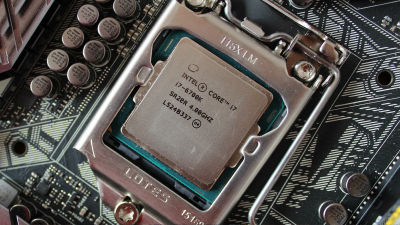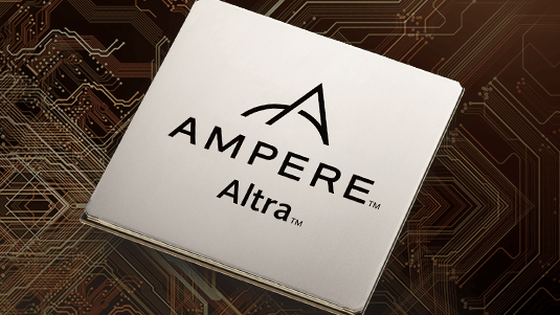Intel Xeon for "Skylake-SP" generation server appeared, which is higher performance "AMD EPYC"?

"Skylake-SP"Intel announced Xeon for servers of the microarchitecture generation. AnandTech is conducting a benchmark test using "Xeon Platinum 8176" and "EPYC 7601" because the clash with the server market with the already announced rival AMD's new processor "EPYC 7000" series is about to begin .
Sizing Up Servers: Intel's Skylake-SP Xeon versus AMD's EPYC 7000 - The Server CPU Battle of the Decade?
http://www.anandtech.com/show/11544/intel-skylake-ep-vs-amd-epyc-7000-cpu-battle-of-the-decade
◆ "Skylake-SP" generation Xeon
The table below compares the specifications of AMD EPYC 7000 series, Intel Skylake - SP Xeon, Intel Broadwell - EP Xeon. The maximum number of cores per processor is 28 for Skylake - SP and 32 for EPYC.
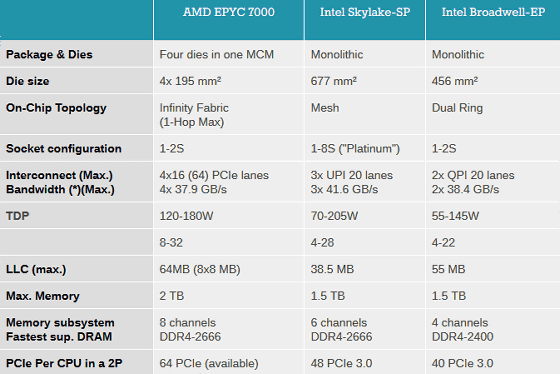
While the old generation "Intel Xeon E 5" (Broadwell-EP) was a 256 KB L2 cache memory, the new generation Xeon processor adopting the "Skylake-SP" architecture adopted 1 MB L2 cache memory, We have evolved to add "AVX - 512" units. Adoption of AVX-512 is a function not found in AMD's server processor "EPYC", it is one of the big advantages of Intel processor.
However, in reality, due to the complexity of the AVX-512 ISA, optimization work with Intel engineers is indispensable to use with software, and AnandTech points out that it takes a long time to fully demonstrate the performance I will. Furthermore, compared to the case without the conventional AVX 2.0 and AVX functions, the AVX - 512 adopts a drop in the number of clocks and must be used, so the superiority of AVX - 512 adoption will be further reduced.
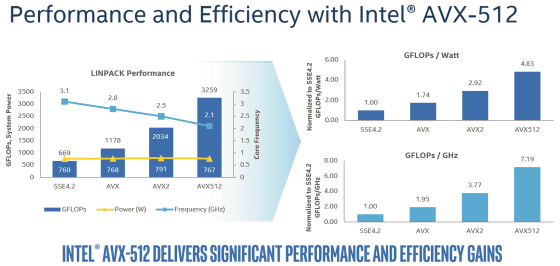
By the way, Intel 's Skylake - SP Xeon adopts a multicore topology that integrates up to 28 cores in the mesh to the AMD EPYC of Multi - Chip Module (MCM) configuration which connects multiple CPU dies as modules In terms of manufacturing cost, AMD is advantageous.
Intel has revamped the naming scheme that we have used over generations in the Skylake-SP generation. It is the lineup of Gold 5000/6000 series, Silver 4000 series, Bronze 3000 series below, with the top Platinum 8000 series being the lead.
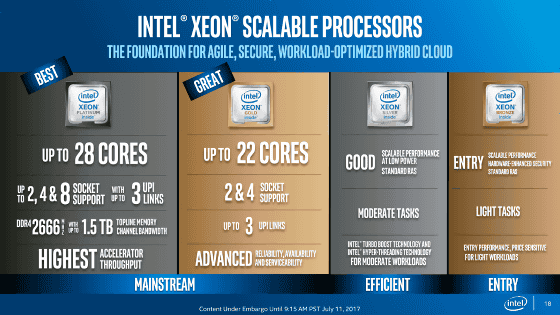
Xeon Patinum, the successor to the conventional Xeon E7 series, supports up to 8 sockets (8 CPUs), and 24 cores, 26 cores, and 28 cores are prepared.
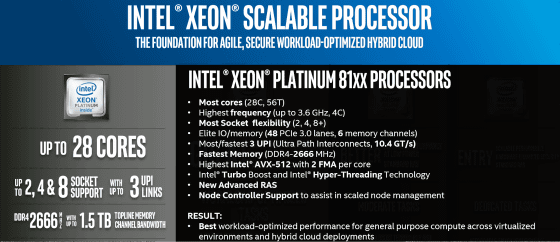
Skylake - SP Xeon adopts a turbo mode, in which not all CPU cores operate at the rated clock, but changes the number of clocks according to the number of active CPU cores. The maximum number of clocks according to the number of active cores of "Xeon Platinum 8180" is as follows, and the maximum frequency differs depending on whether AVX function exists or not.

Also, the number of boost cores operating at the maximum clock number also varies depending on the number of clock cycles. For example, in the case of 8180 (AVX-512 valid), the maximum number of clocks that all 28 cores operate is 2.3 GHz.

The price of Skylake-SP generation Xeon Platinum is as follows. "8180 M" that supports extended DRAM is about twice as high as the previous generation's top model of $ 13,011 (about 1.48 million yen). Even '8180' for ordinary DRAM is bullish price setting of over $ 10,000 (about 113 million yen). Although it seems to be crazy pricing, although large clients who introduce a large amount of Xeon Platinum enter into contracts individually, a considerable discount is expected, although some analysts are asking for the price of Skylake-SP generation He said that he was critical of him.

It is like this when aligning models that are likely to compete in the price range with the rival's AMD EPYC processor. Intel's pricing is generally more expensive than AMD, which reflects Intel's idea that clients should pay a premium for their achievements. Nonetheless, the EPYC's top model "7601" is $ 4,200 (about 480,000 yen) and there are no more models, so Xeon Platinum's pricing is not subject to alignment. Even considering the merit that the 8 socket configuration can be used, the price of the Xeon Plutinam 28 core model, which is about twice as much as the conventional model, seems to be fairly expensive.

◆ Performance comparison
AnandTech is "Intel Xeon Platinum 8176"(2.1 GHz, 28 cores, L3 cache 38.5 MB, TDP 165 W) and"AMD EPYC 7601"(2.2 GHz, 32 cores, L3 cache 8 MB × 8, TDP 180 W), old model"Intel Xeon E 5-2699"(2.2 GHz, 22 cores, L3 cache 55 MB, TDP 145 W) are compared by various benchmark tests. All tests are done with Ubuntu Server Xenial 16.04.2 LTS (Linux kernel 4.4.0 64 bit).

The score of "John McCalpin's Stream bandwidth benchmark" for checking the bandwidth of the memory subsystem is the predominance of EPYC 7601.

A score of "LMBench" to check the latency (delay) between memory and cache. If the block size is less than 8 MB, EPYC 7601 is a postal title, but Xeon dominates when it is larger than that. However, in areas with large block sizes, Broadwell-EP generation Xeon E5-2699 is the best result.

Xeon Platinum 8176 dominates the compression test by "LZMA".

However, EPYC 7601 dominates thawing test by "LZMA".

Performance test of MySQL database using "Sysbench". EPYC is very disadvantageous in a small database where L3 cache is important.

In the test of "MultiJVM SPECJbb" for examining the performance of Java, Xeon Platinum 8176 and EPYC 7601 are almost equal.

In the "Apache Spark 2.1" test for big data, Xeon Platinum 8176 slightly exceeds EPYC 7601.

In "C-ray" to investigate the performance of floating-point arithmetic, Xeon Platinum 8176 lost to EPYC 7601.

Even for "POV - Ray 3.7" for floating point calculation, EPYC 7601 surpassed Xeon Platinum 8176.

The power consumption when using the previous thread in the POV - Ray test is as follows. Low power consumption of EPYC 7601 stands out.

After completing various benchmark tests, AnandTech said that the AMD system was only one week and the Intel system could only be used for two weeks, so although the lack of tuning is obvious, the overall image is clear, stating price If performance is important, we conclude that EPYC has a very strong competitiveness against Skyalake-EP. Skylake - SP 's Xeon has a powerful system called 8 - socket configuration, but the server market seeking such high specs is shrinking rapidly, and many users will be satisfied with dual sockets.
However, when using high-performance computing (HPC) software, Intel's AVX 2.0 and AVX-512 are great advantages, and the high price of Intel Xeon is not an obstacle in consideration of reliability etc. "I think," AnandTech says. Either way, EPYC, which is much faster than Skylake-SP by floating point arithmetic, seems to be certain that Intel's powerful rival as a server CPU has become a strong competitor.
Related Posts:
in Hardware, Posted by darkhorse_log


